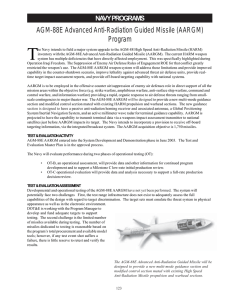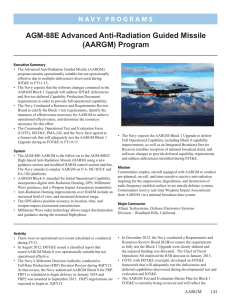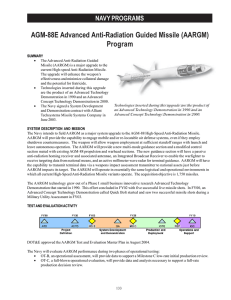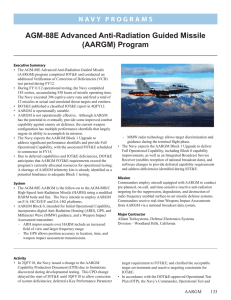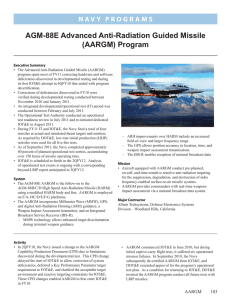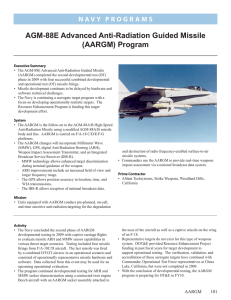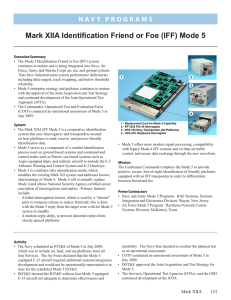AGM-88E Advanced Anti-Radiation Guided Missile (AARGM) Program
advertisement
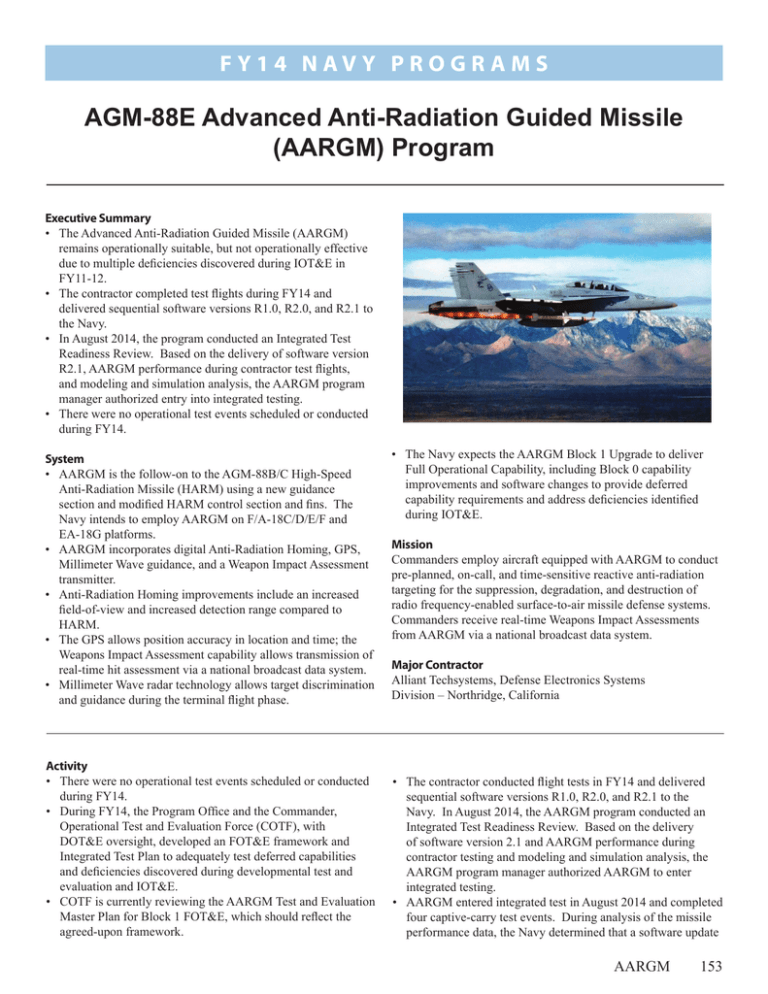
F Y14 N av y P R O G R A M S AGM-88E Advanced Anti-Radiation Guided Missile (AARGM) Program Executive Summary • The Advanced Anti-Radiation Guided Missile (AARGM) remains operationally suitable, but not operationally effective due to multiple deficiencies discovered during IOT&E in FY11-12. • The contractor completed test flights during FY14 and delivered sequential software versions R1.0, R2.0, and R2.1 to the Navy. • In August 2014, the program conducted an Integrated Test Readiness Review. Based on the delivery of software version R2.1, AARGM performance during contractor test flights, and modeling and simulation analysis, the AARGM program manager authorized entry into integrated testing. • There were no operational test events scheduled or conducted during FY14. System • AARGM is the follow-on to the AGM-88B/C High-Speed Anti-Radiation Missile (HARM) using a new guidance section and modified HARM control section and fins. The Navy intends to employ AARGM on F/A-18C/D/E/F and EA-18G platforms. • AARGM incorporates digital Anti-Radiation Homing, GPS, Millimeter Wave guidance, and a Weapon Impact Assessment transmitter. • Anti-Radiation Homing improvements include an increased field-of-view and increased detection range compared to HARM. • The GPS allows position accuracy in location and time; the Weapons Impact Assessment capability allows transmission of real-time hit assessment via a national broadcast data system. • Millimeter Wave radar technology allows target discrimination and guidance during the terminal flight phase. Activity • There were no operational test events scheduled or conducted during FY14. • During FY14, the Program Office and the Commander, Operational Test and Evaluation Force (COTF), with DOT&E oversight, developed an FOT&E framework and Integrated Test Plan to adequately test deferred capabilities and deficiencies discovered during developmental test and evaluation and IOT&E. • COTF is currently reviewing the AARGM Test and Evaluation Master Plan for Block 1 FOT&E, which should reflect the agreed-upon framework. • The Navy expects the AARGM Block 1 Upgrade to deliver Full Operational Capability, including Block 0 capability improvements and software changes to provide deferred capability requirements and address deficiencies identified during IOT&E. Mission Commanders employ aircraft equipped with AARGM to conduct pre-planned, on-call, and time-sensitive reactive anti-radiation targeting for the suppression, degradation, and destruction of radio frequency-enabled surface-to-air missile defense systems. Commanders receive real-time Weapons Impact Assessments from AARGM via a national broadcast data system. Major Contractor Alliant Techsystems, Defense Electronics Systems Division – Northridge, California • The contractor conducted flight tests in FY14 and delivered sequential software versions R1.0, R2.0, and R2.1 to the Navy. In August 2014, the AARGM program conducted an Integrated Test Readiness Review. Based on the delivery of software version 2.1 and AARGM performance during contractor testing and modeling and simulation analysis, the AARGM program manager authorized AARGM to enter integrated testing. • AARGM entered integrated test in August 2014 and completed four captive-carry test events. During analysis of the missile performance data, the Navy determined that a software update AARGM 153 F Y14 N av y P R O G R A M S is required and delayed the planned captive-carry and live fire test events for the remainder of 1QFY15. Integrated test flights are expected to resume in 2QFY15. Assessment • The FY14 status remains unchanged from the FY13 report. • AARGM is operationally suitable, but not operationally effective. The details of these deficiencies are discussed in the classified DOT&E IOT&E report published in August 2012. • The AARGM program has entered integrated test based on the delivery of the R2.1 software and contractor and developmental testing. The test design and identified resources should provide a rigorous evaluation of the corrections of deficiencies discovered in IOT&E and the 154 AARGM deferred Key Performance Parameter. The early integrated testing of captive-carry and live-fire events are designed to provide insight and exposure to all capabilities and conditions. These initial test events should give an early indication of the performance of the missile and stability of the system. Recommendations • Status of Previous Recommendations. The Navy satisfied the previous recommendation. • FY14 Recommendations. The Navy should: 1. Complete the integrated test period as planned for FY15. 2. Complete the detailed plan for FOT&E based on the utility of integrated test data for operational test objectives.
